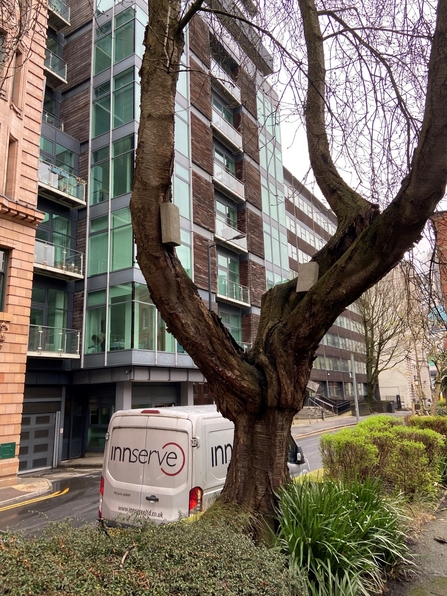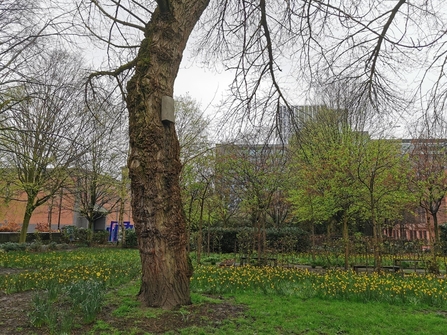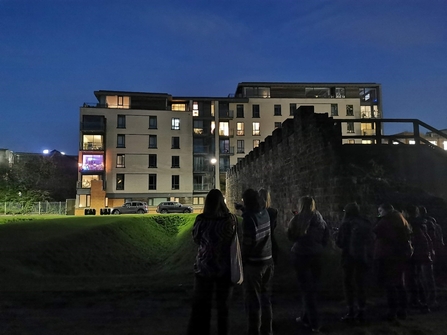In an effort to enhance biodiversity and support nature’s recovery, we have been working with Manchester City Council to install nestboxes for both birds and bats in the bustling urban landscape of Deansgate. This initiative not only aims to provide nesting options for various species but also aligns with the Manchester Biodiversity Strategy, focusing on target species crucial for nature’s recovery.
Bringing biodiversity to Deansgate

Nestboxes in Deansgate, by Cris Davenport
We have strategically placed a mix of wooden bird boxes with recycled plastic protective shells and eco-friendly bat boxes made of ecostyrocrete, a sustainable blend of concrete and recycled polystyrene, around Deansgate. These boxes can be found in key locations, such as St Johns Park, Parsonage Gardens, and soon along the Rochdale Canal, creating ideal habitats for species like common pipistrelle and Daubenton’s bats as well as house sparrows and other birds.
The Canal and River Trust and Bridgewater Hall have been active partners in this initiative, focusing on enhancing aquatic plants along the canal. The addition of reedbeds and floating vegetation platforms is not only essential for food and shelter but also contributes to water quality improvement by reducing pollutants and oxygenating the water.
I have been so impressed by the level of collective action from both community groups and partners towards biodiversity and the environment especially in such a dense urban setting, I look forward to continued collaborationManchester Project Officer at The Wildlife Trust for Lancashire, Manchester & North Merseyside

Bat nestbox installed in St Johns Park, Deansgate, by Cris Davenport
The success of this project is not just limited to environmental benefits. Community groups, such as Castlefield Clean and Green and Plant Cooperative, have actively participated in enhancing greenspaces throughout the city. These collective efforts strive to create a better city centre, promoting both the well-being of nature and the community. Numerous studies have shown that greenspaces and wildlife contribute positively to mental and physical health.
We also ran some great bat box building sessions for the public, with the help of the Science and Industry Museum, National Trust and Plant Cooperative, where they could take the box they built home for their own garden.

Nestbox building session with Plant Cooperative, by Cris Davenport
The chosen species play a vital role in Manchester's Biodiversity Strategy for nature recovery. By encouraging the presence of these species, Lancashire Wildlife Trust contributes significantly to the overall biodiversity of the canals and broader urban greenspaces.
To ensure the health of the canal and support target species, the trust conducted an investigation using environmental DNA.
“Environmental DNA (eDNA) is DNA that has been left behind by organisms in their environment in the form of skin cells, hair, mucus, faeces, urine, blood, saliva, gametes, and deceased remains. eDNA accumulates in water, sediment, soil and air, but persists for different times in these environments. eDNA can persist for hours to weeks in water compared to months to years in sediment.” – Nature Metrics
A water sample from Bridgewater Basin underwent lab analysis and the report revealed 38 different invertebrate DNA samples, over half were identified to the species level, including insects like midges and flies, which are crucial food sources for many insectivores higher up the food chain. While the report indicates a good baseline of insect prey species, efforts are needed to enhance species richness and diversity. With encouraging results, Lancashire Wildlife Trust aims to build on this foundation, working towards broader improvements in the local ecosystem.

Students using detectors to locate bats in Deansgate, by Cris Davenport
By addressing both nesting options and the health of the canal, the project aims to create a thriving urban ecosystem that not only supports biodiversity but also enhances the quality of life for the community. As these initiatives continue to unfold, the hope is that Deansgate will serve as a shining example of how urban areas can harmonise with nature for the benefit of all.
Keep an eye out for these nest boxes and become part of the positive change for Deansgate's wildlife by recording species you see on apps such as iNaturalist or directly to the Greater Manchester Local Record Centre (GMLRC). See our My Wild Garden Project for how you can improve your own green spaces for wildlife and if you want to get involved in Deansgate volunteering, join active community groups such as Clean & Green Castlefield and Plant Corporative.
